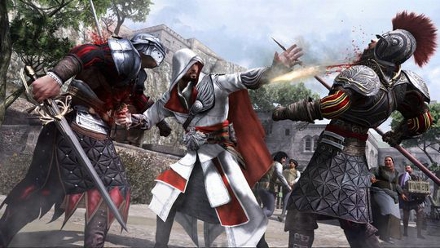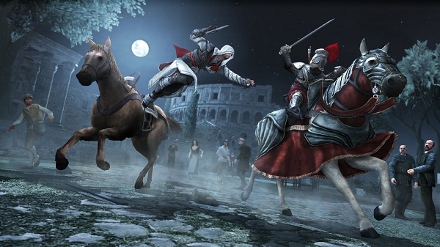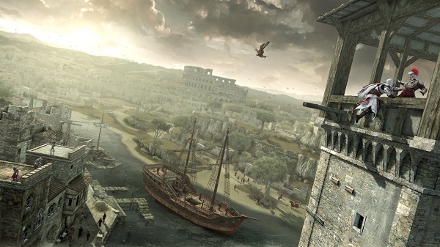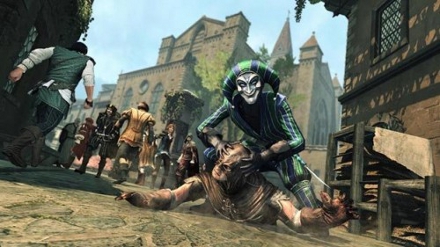Reviews
Review: Assassin’s Creed: Brotherhood
December 23, 2010, Author: Andy Corrigan
Ah, Assassin’s Creed. This series has been somewhat of a puzzle for me. I very much enjoyed the first game in spite of its obvious flaws and in my circles I often found myself to be one of the few defenders of its free-running thrills. It featured what was undoubtedly one of my favourite game engines of all time, but thanks to an undeniable amount of repetition, it certainly couldn’t be considered one of my favourite games of all time. With the second game I pre-ordered as soon as I possibly could, awaiting it with high hopes, but later cancelled once I’d played a very early and clunky build at Eurogamer 2009. In fact, I only just picked up the sequel in the light of this very review of Assassin’s Creed’s first foray into what I was led to believe was a ‘spin-off’.
I found playing the sequel a bit of an eye-opener, instantly wishing that I hadn’t cancelled that pre-order last year. I found myself in awe of how Ubi had listened, then provided more of the great elements of the first title, while adding a better mission structure and removing all traces of the grind that nearly ruined it as a franchise in the eyes of the media. It is probably now fairly regarded as the big title that Ubi had hoped in 2007. Even with that turnaround of success, Brotherhood worried me; was it a lazily developed cash-in, just a year after the last game? Would it really add anything revolutionary compared to last year’s instalment? Can the game engine really lend itself to an enjoyable online mode?
The answers to those three questions in short are; no, yes, and hell yes! Want more detail? You know what to do to find out!
‘The Italian Job’
Just as in Assassin’s Creed II, you are treated to a Desmond-voiced retelling of the events so far, before watching Ezio try to attack an unknown man. A war of words takes place as the two men struggle, when Ezio manages to get a nick on his target’s neck before he fights free. Just as he’s about to give chase, the memory file that Desmond is replaying corrupts and kicks him out . Starting again from exactly where the previous game ended, you have to guide Ezio’s escape from the Vatican along with his Uncle Mario. Once they have safely returned to Monteriggioni, Ezio gathers the other assassins to explain of his trials and then tries to settle back into relative normality, which includes entering into a love affair with Caterina Sforza (who you might remember from the previous game). After nailing Caterina, Monteriggioni is attacked, led by the man from the flashback, and now named as Cesare Borgia. Cesare is the son of Rodrigo; Ezio’s main thorn in the side in Assassin’s Creed II. After losing his uncle in the attack and having his new lover and the much-coveted Apple of Eden taken by the Borgia, Ezio escapes with his family and decides to head back to Rome to tie up all the loose ends.
Coming into Brotherhood, I had been under the distinct impression that it was something of a spin-off; a side-story designed to flesh out Ezio more than it was the over-arching storyline of the series. How wrong I was. Brotherhood is even more progressive than the previous game and furthers the storyline a surprising amount. Desmond also continues his trend of playing a more active part in proceedings, particularly at the beginning where our small band of modern-day Assassins relocate to a new (but familiar) safe house to continue Ezio’s memories without the prying eyes of Abstergo’s Templars.

Ezio's a pain in the neck...
I do have to mention that there is one minor annoyance in the opening portions as Ezio. After a short period where you’re led to believe you’ll keep all your gear earned in Assassin’s Creed II, you lose nearly all of it in a contrived manner during the attack on Monteriggioni (bar your gun and one hidden blade). It makes sense in terms of the story and restores the natural progression expected in games, but I hate being teased with power in brief opening sections only to have it stripped from me. It even bizarrely takes away the ability to do longer vertical jumps, leaving you to, essentially, buy it back later on. Just start me with nothing if that’s what you wanted, I’d have been happier.
Rome wasn’t rebuilt in a day…
Let me get this out of the way right now; Ubisoft have implemented the single most important improvement in the series’ history. That’s right… The ‘Gentle Push’ action no longer sees your assassin wave his arm around like an Alzheimers-suffering Jedi when there’s no-one around to push! I jest, of course, but this is just an example of how the formula has been tightened in almost every aspect.
A large part of the standard Assassin’s Creed gameplay foundations are still very much evident, especially in the way it handles, but throughout the experience it will continue to throw up new tricks for you to learn and the structure is certainly a little different to either of the previous titles. Take the combat for example; notoriously easy (but I’d argue it’s meant to be; you’re a bad-ass Assassin skilled in combat, not a novice, and no one moaned when Batman did it…) and based around fluid blocks and counters to defeat the enemies. This hasn’t changed, but Ubisoft have taken the time to liven it up a bit with minor additions, such as kicks that’ll break an opponent’s defence, though easily the most impressive addition is the execution streak.
If you achieve an execution in combat (either by disarming or countering, or just spamming the hell out of the attack button), while that is being performed you can highlight another nearby enemy. Hit the attack button at this point and Ezio will launch himself into attack on that selected guard before he’s even had time to wipe the blood off his blade. Play your cards just right and you can string together huge chains of deeply satisfying and gory one-hit kills. It’s really not as easy as it sounds, but it is every bit as fun to perform. There’s also the reward of the enemy hierarchy still present; take out one of the heavily armoured or skilled opponents first, and the lower ranking guards will crap their pants and either leg it in an entertaining fashion or drop to their knees to beg for your forgiveness (no, I didn’t let any of them live, for the record).

You've got horse armour!
Adding another dimension to the gameplay is the ability to ride your horse in any part of the map. Heavily populated cities, small towns; it doesn’t matter, if you can get there on foot, you can get there on horse. This not only speeds up travel on one hand, but can also bring out some brilliant chases and combat sequences.
Then there are the new toys to add into to the equation, with the crossbow being my personal favourite, especially when it comes to the more stealthy sections of gameplay. It allows you to take out guards at a decent distance without alerting their peers, and is also a useful part of your arsenal when taking down cowardly runners. Another nice touch is the ability to shoot poisoned darts from a distance using your gun attachment, meaning you can stalk from the rooftops, tag your man and watch as his sickness-based delirium takes a hold, before he convulses and collapses, breathing his last breath. Once again, Da Vinci (aging a fair bit) acts the Q to your Bond, offering (for a price) some new gadgets, such as a parachute. This is not vital to the game, but is very cool to play about with.
The missions themselves follow a much more logical build up this time around, feeling like they’ve received a huge structural improvement with not many of the various side-quests feeling like filler. There are a set of missions in particular for a certain returning character that I really can’t spoil for you, as they are so monumentally awesome that I found myself replaying them again and again (replaying the memories being another nifty feature introduced in this iteration). The set-up, the build up, the execution of these missions is absolutely perfect and I hope to see a lot more of this when Assassin’s Creed III hits next year. A large part of these particular quests include either a very welcome stealthy approach or unadulterated, uninterrupted Prince of Persia style environment navigation where the climb is almost a puzzle in itself. All the missions feature two levels of completion. Just finishing the missions by the most basic of standards will give you a ‘50% Synchronisation’, and to get a 100% you will need to adhere to some extra-but-optional conditions. These can involve using certain weaponry, not killing anyone but your target, or not being seen. A nice little system that introduces extra challenge for those that want it.
Introduced in Assassin’s Creed II was a basic renovation feature for Monteriggioni, which allowed you to earn money passively to spend on upgrades, health and even fancy paintings to hang in your hall; a nice feature which has been expanded on here. Instead of a base of operations, you are actively rebuilding Rome under the noses of the Borgia oppressors and as such you can buy shops, stables, guild houses and banks all over the map. You can even purchase the major landmarks, such as the crumbling Coliseum, which exponentially increases your regularly delivered pay-packet. Before you can purchase businesses and buildings in particular areas, you may have to rid the area of the Borgia presence and to do this you must get into a stronghold, kill a General, then burn their flag-bearing tower to the ground. These aren’t always as generic as you’d expect, especially when you have to give chase before the general escapes, or face having to wait for the daily guard rotation to change.
Where quick travel was experimented with in ACII, the new system is a huge improvement all round and can be accessed by purchasing the entrances to secret underground tunnels. Dotted more frequently around the map than with the previous system of an old-fashioned taxi, their inclusion gives you more time to do more of the awesome stuff rather than spending a huge amount of time traversing from one area to another. Another aspect to the business side of the game is shop quests, these essentially give you a point in looting and searching out the treasure across the map as certain shops will have a wish-list of gems and items, which, once acquired, can be exchanged for some amazing, previously unavailable weapons and items.
So at this point, you may be wondering where the ‘Brotherhood’ side of the game is. If you are, I can tell you that around the halfway point, Ezio will task himself with rebuilding the Brotherhood of the Assassin’s. By helping out villagers in trouble, you can recruit them to your cause and call them into play at any time with a press of the LB. Initially in their recruitment, they will be quite weak and highly susceptible to death, usually from just being looked at. Thankfully, you can send them on missions in the periods you don’t need them. These missions are not interactive; you don’t see it happen, you don’t play the mission, you’ll simply lose their services for a set amount of time. It’s a system that I’d put in the same bracket as skill learning in particular MMO’s (Eve Online being the first one to spring to mind).
During the levelling up process you’ll unlock new weapons, armour and skills for them that’ll help you out when you come to need them. Another benefit from recruiting the Assassin’s is the Arrow Storm. In a situation where you need all the guards wiped out instantly? Hold the LB and your Assassin’s will rain arrows down upon your foes without anyone being clued in on your involvement. This is on limited use (with a cool-down period) and you need eight Assassins free to be able to use it. It’s a great addition that not only acts a nice distraction, but makes you feel like an evil genius stood on the side-lines having your minions perform your bidding.
Lastly, this addition will probably appeal to the Metal Gear Solid fans out there, but you can access a VR training mode in the Animus menu. These are made up of some fun little challenges in a computerised chamber, testing you in areas such as stealth and combat. Not only is the vibe of this mode very MGS, but you can also use it to unlock a Raiden character model for the main game, another aspect to Ubisoft and Konami’s strange cross-franchise relationship.

Does actually look this good!
As sharp as Ezio’s blade
Let’s face it, Assassin’s Creed has always been a fantastic looking game and I count the series as one of the most stylish this generation. Brotherhood is no different, with amazingly detailed textures, brilliant lighting and filtering effects are on evident at every turn, highlighting just how much love and care went into this title. This is every bit as superb as the Assassin’s engine has ever looked, and even better when you take into account the beautiful new animations. It’s rare when you can say that the NPC’s have received nearly the same level of care and attention as the main characters, but through every visible action this is clearly the case.
Some of the previous glitches have also been fixed, I lost track of the amount of times I’d be running at ground level in the previous game, only to bump into an NPC that just appeared in front of me. Thankfully moments like that are practically non-existent in Brotherhood and just an example of how everything has just been tightened and refined and, to be fair, that’s all it ever needed visually.
It’s-a-meee! Ezio!
This is a game that sounds great too, from the immersive and dramatic soundtrack (without Tinie Tempah, thankfully) to the continually impressive voice acting on offer. The highest end of the spectrum here is with the modern assassin’s, where Nolan North (yes, him again) returns as Desmond, Kristen Bell is still the same natural fit for Lucy as she always was, and even friend of TIMJ, Danny Wallace, sounds less robotic this time around in his voice work for tetchy cynic, Shaun.
If I had to pick fault here, it’s problems that were evident in Assassin’s Creed II, with Ezio and some of the other Italian’s sounding a little too stereotypical, but in highlighting that I feel like I’m really trying to nit-pick. The wit, intelligent humour, and hell, even some of the philosophical debate to be found in the game is extremely well written, no matter which era you’re in.
Stabbing your friends in the back…
It pleases me greatly to say that the multiplayer in Brotherhood not only works, but is the real deal. Cleverly written into the lore and mythology of the Assassin’s Creed franchise in a way that’s not unlike Bioshock 2’s online mode (or even Portal’s relevance to the Half-Life universe), the online mode entertains as much as it surprises. As explained in the intro, fronted by villain Warren Vidic, you are one of many Abstergo employees hired to learn the skills of the Assassins. You can choose here to do an introductory session, and I highly suggest that you take up this option before jumping in.
The set-up may seem confusing at first, but it’s delightfully simple once you get the hang of it. In the game you’ll be hunting other players, who in turn will be hunting others, maybe even you. After selecting your character (you can only have one of each avatar in the match, selected on a first come first serve basis), you are plonked bang into the middle of a bustling map and provided a picture of your current target. Thankfully, along with your eyes and your wits, you also have a compass that’ll point you in the general direction of your target and this will highlight fully when in close proximity, but not advertise exactly who and where they are. There are many lookalikes in these maps and it’s all too easy to strike an innocent civilian, unless your target makes his presence obvious of course.
The way to earn the most points for a kill is to remain hidden, blend in with the crowd and then strike when no-one is watching. If you make too many stupid moves, such as running at your target, you’ll become highlighted on their HUD and they’ll have the ability to counter your kill with a well-timed button press or make a run for it. Obviously, to strike without the fear of them pulling off a counter, you have to remain socially stealthy. All the while, you could be seeing the wrong end of a pointy stick too, if you’re not careful.
This allows for some brilliantly tense moments, such as blending in with a rabble at a stall while your victim passes oblivious to the blade about to penetrate their stomach. Not only that, it’ll make you paranoid as you keep a close eye on the movements of passers-by, looking for that tell-tale giveaway that may never actually come. I would have been happy with that as a game, light as it is, but thanks to the levelling system, you can add abilities, perks, and customisations into the mix. For example, an early ability you’ll unlock is the ability to change your avatar’s appearance for a brief period to throw off victims and attackers (followed by a 60 second cool-down period). A good example of how to use this was when I became aware of an attacker who had jumped off a roof behind me, causing my HUD to highlight that I was being stalked. Keeping my cool, I rounded a corner, activated my temporary disguise and stayed with a crowd of NPCs while my pursuer walked by confused as I slinked away in the opposite direction. I then watched, satisfied, as he took out a civilian lookalike instead. It’s moments like this that totally make the experience.

Death by harlequin?! Oh, you have to be joking... surely you jest...
Initially you’ll only have two modes open to you. Wanted is a free-for-all for eight people, where you are both hunter and hunted, and the player with the most points at the end wins. Manhunt is a team match, where one team hunts, the other hides, then reverses roles at the end of the round. Here you can earn more points while working as a team, and killing a target next to a team-mate vastly increases scores further. Alliance unlocks at level five, with features three teams of two, and you’re only allowed to hunt one of the other teams in a deadly triangle. Advanced Wanted, unlocked at level twelve, is the same principle as before, but your compass, while still active, is a lot more limited.
It was all too easy to assume that this could have been a poorly implemented, tacked-on online mode, but I have to say that this is not just a great aside from the campaign, but is easily my online highlight of the year. Solid, deep and highly addictive. Well supported by Ubi too, with two lots of free DLC thus far. This is an online component I’ll be playing for some time to come.
Much more than a spin-off.
We’ve had a bit of a weird relationship with Ubisoft since they started sending us review copies. You see, for most of what they’ve sent has ended up being panned or have been given luke-warm reviews, and as a long-time fan of the company for their major output, I’m really pleased to be able to address the balance and give an unwavering recommendation for Brotherhood. If Assassin’s Creed II was the game the first should have been, then this is evidence of a franchise in full stride and about to hit its peak. With a single player campaign that is leagues ahead of anything that’s come before (although I don’t think I’m alone in saying that it’s time for Ezio to step aside), an original online mode that not only works, but stands out amongst the sea of drab online shooters, you’re looking at a game that is close to perfect by today’s standards.
Platforms: PC, PS3, Xbox 360 | Tagged Assassin's Creed:Brotherhood, Assassins Creed, Blade, Ezio, Hidden blades, Jade Raymond, Ubisoft, Ubisoft Montreal



